Chapter 8 - DNA Replication, Binary Fission, Mitosis
All cells divide
Unicellular organisms divide in order to reproduce.
Cell division produces a continuous supply of replacement cells in multicellular organisms.
Sexual life cycles
Eukaryotic cells divide by mitosis
A fertilized egg, or zygote, divides by mitosis.
The fetus grows and develops into a mature adult consisting of countless cells.
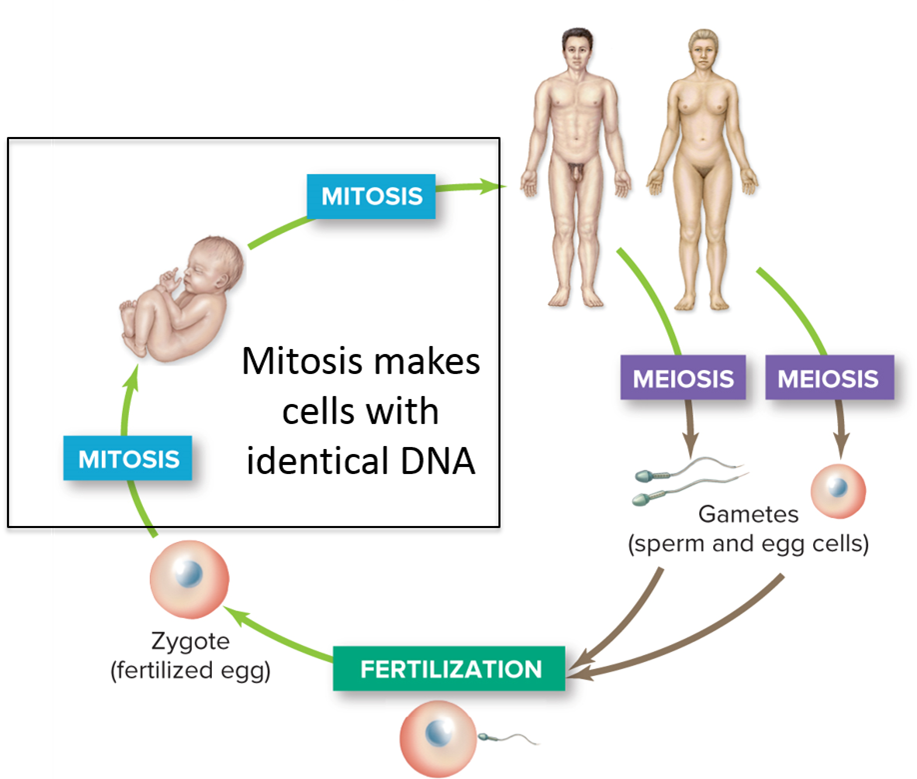
Eukaryotic cells divide by meiosis
Each mature individual produces sex cells by another form of division called meiosis
Meiosis occurs only during reproduction

Gametes fuse during fetilization
Sex cells produced by meiosis contain half the DNA as body cells.
As fertilization, the zygote inherits DNA from both gametes
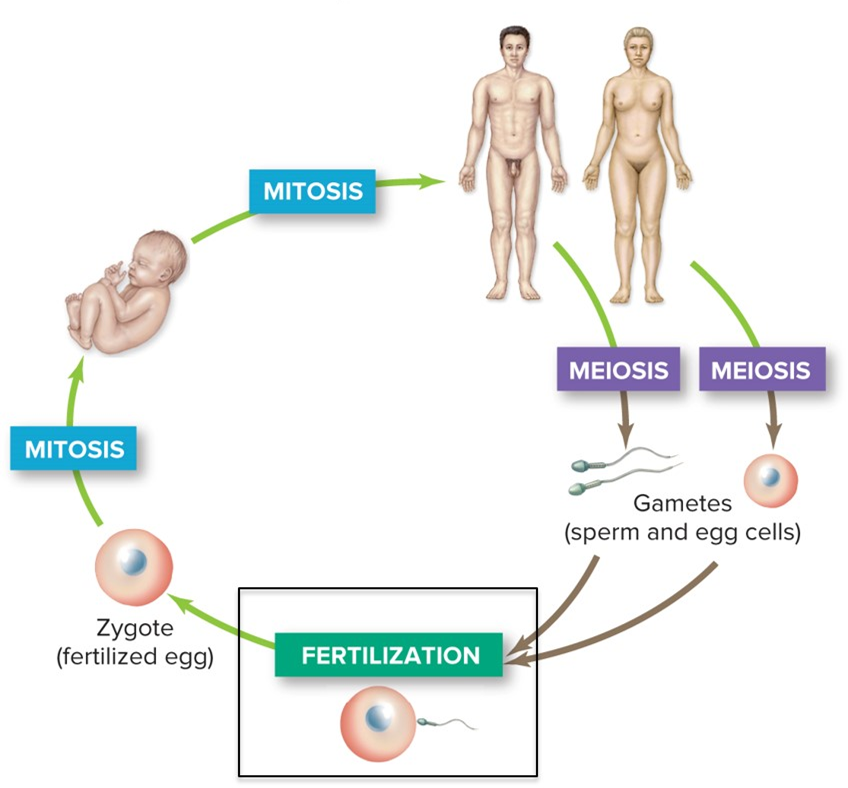
Mitosis has many roles
Mitotic cell divisions allow an organism to grow and develop, repair tissues, and regenerate lost body parts.
Some organisms reproduce asexually by mitosis
Mitosis produces body cells
Many rounds of rapid mitosis convert one cell into trillions
Cell death is part of life
Apoptosis, or cell death, is a process that can carve out distinctive structures during development
DNA replication precedes cell divides
For each of the daughter cells from this division to have identical DNA, the cell must first replicate its genome, all of the cell’s genetic material.
DNA replication proceeds in multiple steps
This overview shows that DNA unwinds, each strand binds to complementary nucleotides.
DNA replication builds two new strands
After replication, each DNA molecule has one parental strand and one daughter strand
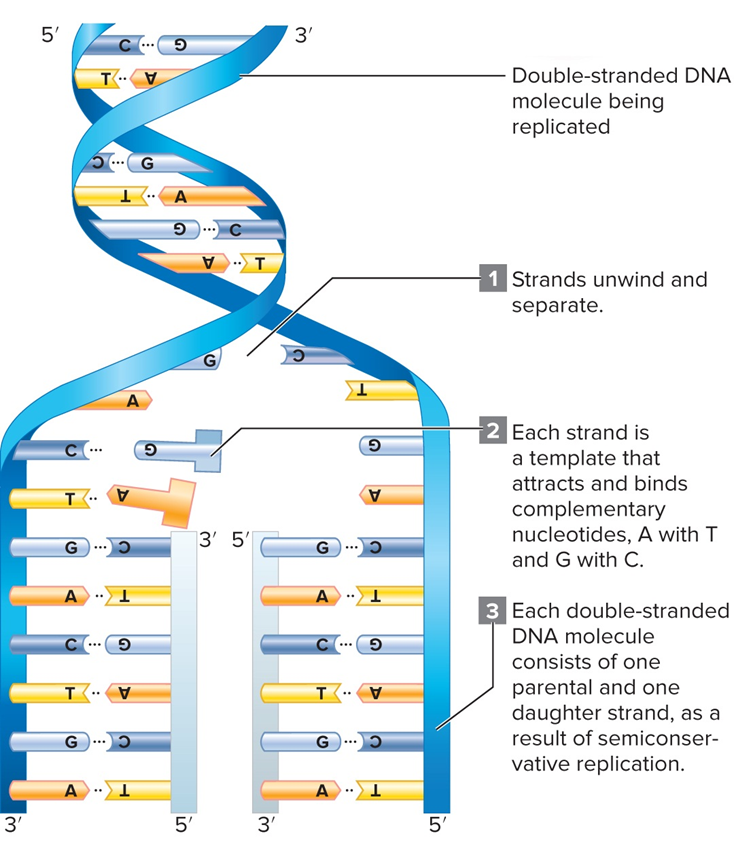
The DNA helix is unwound
Enzymes called helicases unwind the DNA.
Single - strand binding proteins hold the strands apart.
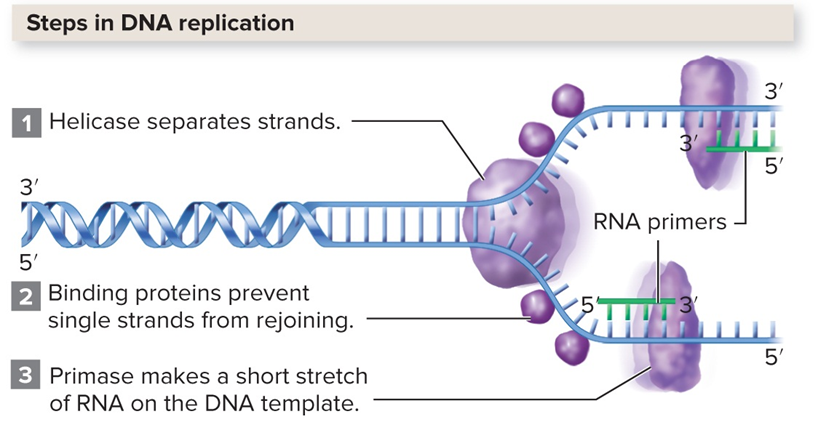
New strands are synthesized
DNA polymerase is the enzyme that makes new DNA strands, starting at the RNA primers
Nucleotides are added to the 3 - prime end
The RNA primers provide 3 - prime ends, where DNA polymerase adds the nucleotides

Leading strand synthesis is continuous
On one strand, DNA polymerase follows helicase as it unzips the DNA. This is the leading strand.
Lagging strand synthesis is discontinuous
On the other strand, DNA polymerase adds nucleotides in the opposite direction from helicase movement. This is the lagging strand.
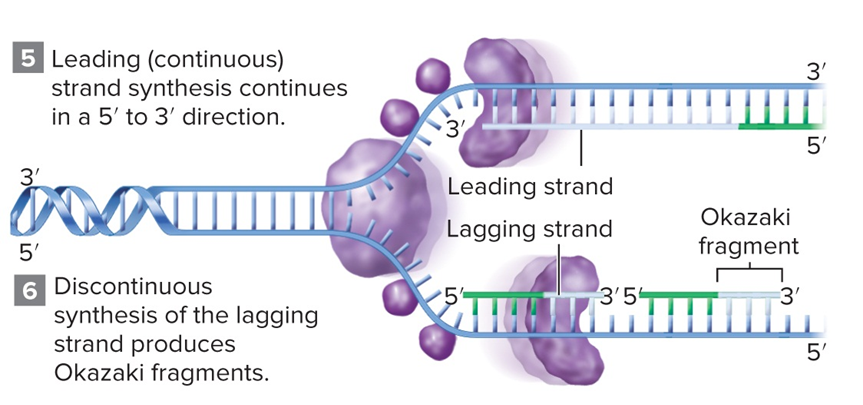
DNA replication has many points of origin
DNA replication begins simultaneously at multiple spots along the chromosomes. These spots are called origin of replication.
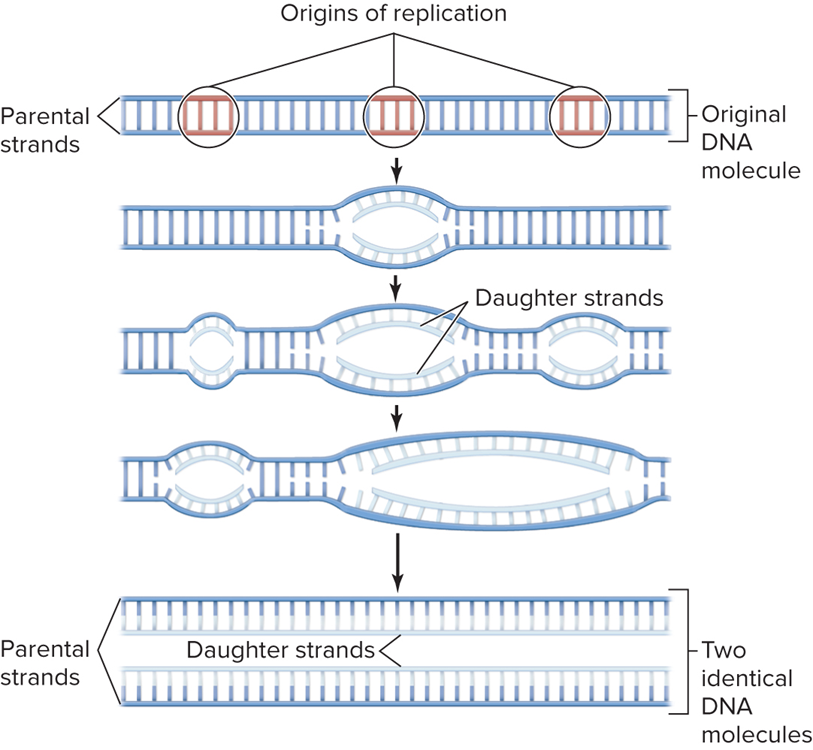
Prokaryotes divide by binary fission
In prokaryotes, reproduction occurs by binary fission an asexual process that replicates DNA and distributes it to two daughter cells
Prokaryotes have one chromosome
Prokaryotes have a single circular chromosome
Prokaryotes replicate their DNA
As the cell prepares to divide, DNA is replicated and attached to the inside of the cell membrane.
Prokaryotes separate two copies of DNA
The cell membrane extends and grows between the two DNA molecules, partitioning them off
Prokaryotes divide into two new cells
The cell divides in half, forming two daughter cells, each identical to the original
Eukaryotes divide by mitosis
Eukaryotic cells do not divide by binary fission. Instead, they divide by mitosis, which is similar but more complex
DNA packaging condenses DNA
Naked DNA wraps histone proteins, forming bead like structures called nucleosomes
Nucleosomes cluster together into chromatin. Scaffold proteins within chromatin keep it tightly packed.
Chromosomes are extra condensed
After DNA is replicated, discrete chromosomes form.
The highly folded chromosomes take up less space and are easier to move than unwound chromatin
The cell cycle is a repeated series of events
Many different events occur in one round of cell division

During interphase, the cell is not dividing
During interphase, the cell replicates its DNA and carries out many functions unrelated to cell division
Interphase includes…
G1 phase
In G1 phase, the cell grow and functions normally. Protein synthesis occurs
G0 phase
During G0 phase, the cell continues to function, but it does replicate its DNA or divide. Most of your cells are currently in G0
S phase
In S phase, the cell replicates its entire genome - every chromosome. Now it is committed to divide
G2 Phase
During G2 phase, the cell produce proteins that are necessary for mitosis.
Mitosis is cell division
Cells leaving G2 phase enter mitosis the division of the nucleus, which is following by cytokinesis the division of the cell itself.
Mitosis is a series of steps
Mitosis is divided into five phases, summarized here
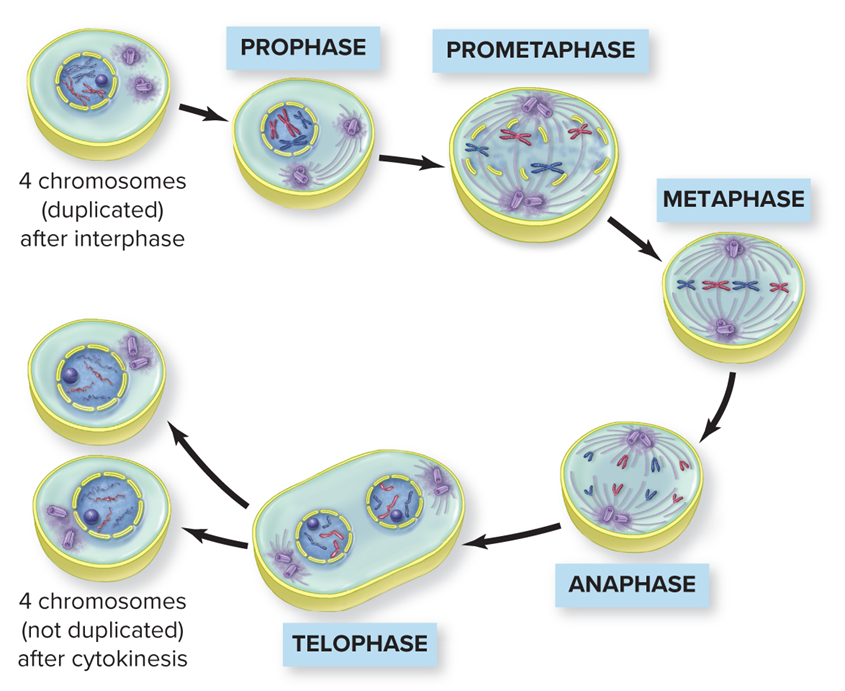
Prophase: Chromosomes and spindle form

Prometaphase: Chromosomes attach to spindle
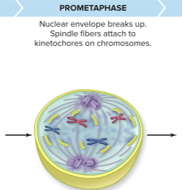
Metaphase: Chromosomes line up
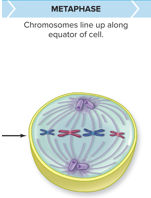
Anaphase: Chromatids separate

Telophase: Two new nuclei form
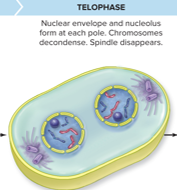
Cytoplasm splits in cytokinesis
In animal cells, the cleavage furrow first appears in telophase as an indentation of the cell membrane.
It deepens as a ring of proteins beneath the cell membrane contracts.

Cancer cells are abnormal
Compared to regular body cells, cancer cells have distinct features:
They lose specialization
They are “immortal” in that they can continue to divide endlessly
They can regenerate the end of their chromosomes. which are celled telomeres

The cell cycle is under tight control
A series of chemical checkpoints regulate the cell cycle
Checkpoints ensure that
all the DNA has replicated
DNA is not damaged
Chromosomes line up and separate properly
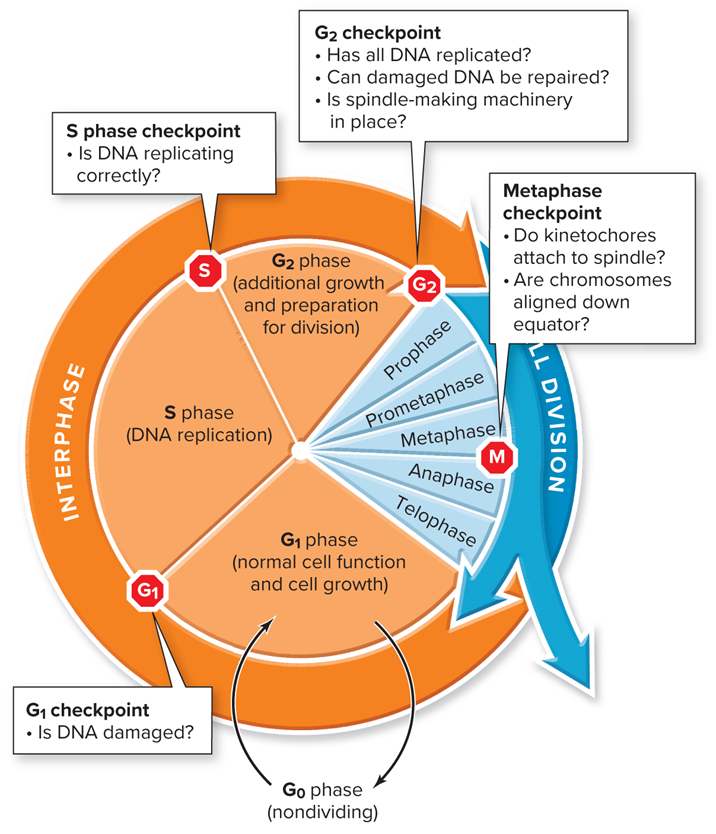
Cancer cells divide out of control
But what if the body loses control of division?
Cells continue to divide when they do not need to, and override the checkpoints.
A tumor an abnormal mass of tissue
Cancerous cells divide out control and form a mass called a tumor
Tumors are either benign (contained) or malignant (spreadable)

Cancer arises when genes are mutated
Mutations alter the function of key cell - cycle control genes.
Cancer may arise from overactive proto - oncogenes /un or from underactive tumor suppressor genes
Cancer risk can vary by ethnicity
Gene mutations such as BRCA1 are inherited, making them more common in particular ethnic groups.
BRCA1 increases the risk of breast cancer
Reducing DNA damage reduces cancer risk
Inherited mutation and factors in the environment that damage DNA can increase cancer risk
Removing tumors is not enough
Surgery may remove rumors, but cells with DNA mutations may already be spreading through the body.
Drugs (chemotherapy) and radiation can selectively kill cancer calls, which are physiologically different from normal cells.
Immunotherapy and gene therapy are the newest approaches that promise to be the most selective.
Apoptosis is programmed cell death
Apoptosis is a set of coordinated events that dismantle a cell from the inside out.
Apoptosis is closely regulated
A receptor on the cell membrane receives a signal to die
Executioner proteins and enzymes begin to break down the components of the cell
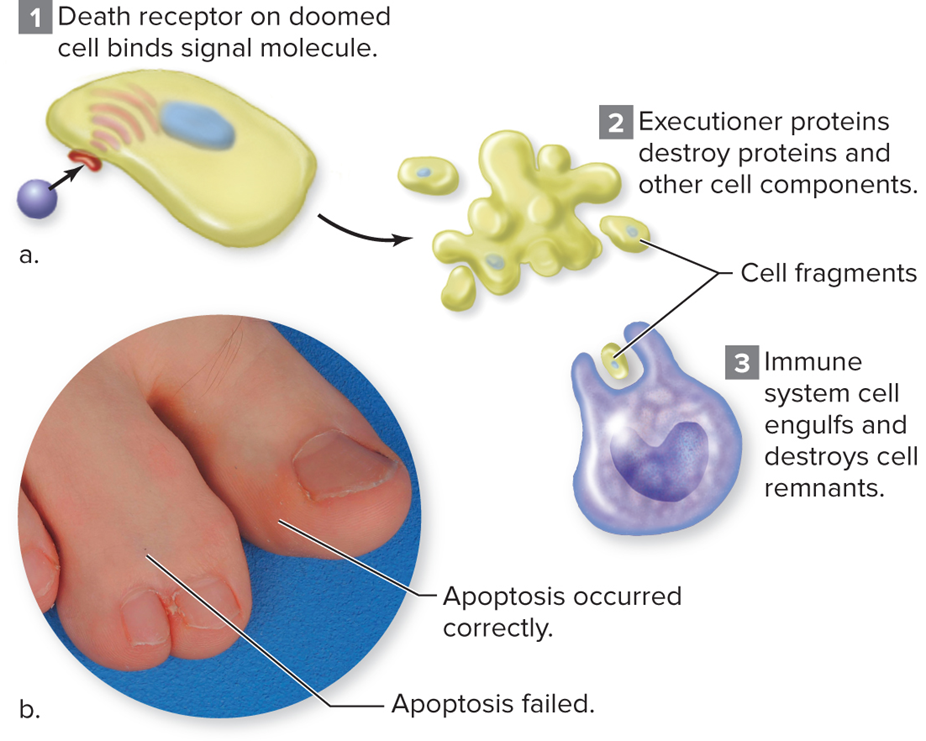
Apoptosis has two functions
Eliminates excess cells, carving out structures and weeds out aging or defective cells.